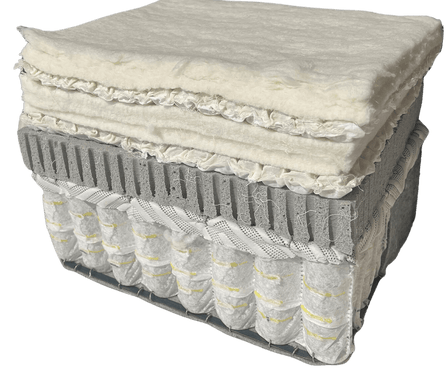Cashmere infused, copper infused, big brands and miracle springs… blah blah blah.
We have been in this industry for a very long time and we have seen it all over and over again — marketing hype! The use of exotic fibres, the reliance on well known brands and the marketing of “unique” spring systems are all part of the spiel used to market beds.
Let’s have a look at how a mattress is made and how it is marketed. And then, let’s seperate the wheat from the chaff.
These days, the majority of mattresses are built using one of two construction methods. Think of a mattress as being made like a sandwich.
The most common construction currently utilises a pocket spring as its support layer. The majority of pocket springs are imported from China and they are produced in very high tech factories for the world market. These springs are used for the majority of factory built mattresses produced in New Zealand. NZ made usually means NZ assembled.
Pocket springs can be all one gauge of wire, or zoned as in 3 zone, 5 zone or 7 zone. The zoning is more of a marketing tool than it is a true benefit. I would challenge anyone to tell the difference between them when used in a finished product. Most retailers will naturally extol the virtues of whichever zoning they sell. Where you will notice a difference is when the pocket spring is encased in a foam box. As pocket springs are a light gauge wire, they benefit from the extra edge support of a foam box construction — it’s something to look for.
The great benefit of a pocket spring over a conventional spring is that, as each spring is encased in an individual calico pocket, it reduces partner disturbance and offers superior pressure relief. On top of the support layer you will be able to choose from a number of different comfort layers. The comfort layers will help you determine your individual preferences. By adding layers of high density foam, memory foam, latex rubber and wool (amongst many other options), we can create different feels such as extra firm, firm, medium, soft and plush. If the layers are of good quality they will last a long time.
Remember to differentiate between support and comfort. Many manufacturers will add hollow fibre Dacron into the quilting used for the top of mattresses. The more hollow fibre Dacron that is used, the more you will notice “body impressions” in your mattress over time. It creates a luxury feel in your mattress but it packs down very quickly. We use little or none for that very reason.
The second most popular construction method is to use layers of high density memory foam and/or pure latex rubber, combined with layers of high density standard foam to create different feels in a non spring mattress construction. This method offers some unique benefits and is becoming more and more popular since it was introduced a couple of decades ago by TEMPUR. The greatest benefits are greatest pressure relief and zero partner disturbance.
The mattress will usually have a high density standard foam layer as its base support layer, on top of which, once again, by way of a sandwich style construction, different layers of varying types of memory foams are used to create different feels. We recommend only high density layers throughout the construction of these mattresses as longevity is the key. For example, most “mattress in a box” products are low density, so as to be shipped inexpensively and requiring only 1 person handling. Avoid these if you are looking for a long term sleep solution… if it looks too good to be true, it probably is.
Hand built mattresses can and will be built using variations of the above methods. They usually also incorporate the use of pure latex or pure wool in their construction. The extra benefit of wool is that it is a natural insulator, wicking moisture away from the body and keeping you dry in both winter and summer.
No man made product comes close in this regard! Be very wary of cooling gels and the like. They are more of a gimmick than an actual useful feature. Pure Latex will last a lifetime when used properly. As with everything else mentioned above, avoid wool infused Dacron and latex which has been laminated to foam. These are cheap ways to incorporate the use of the labels “wool” and “latex” in marketing. Also, many handmade mattresses are made using no glues at all.
Big brands will always have a hefty marketing component built into their price. Often this will be disguised by references to exclusive layers of exotic sounding components such as Cashmere infused, silk infused, copper infused comfort layers etc. The use of the word infused is a dead giveaway……how much is actually in the mattress?
And so, finally… how much should you expect to pay for a quality mattress?
For a queen size, well built mattress with a ten year guarantee I would recommend that you look to spend between $2,000 and $6,000.
For a queen size hand built mattress, you should expect to pay anywhere from $6,500 to $19,000.
Keep an eye out for sales as this is a crowded market, and try to avoid the marketing hype.








